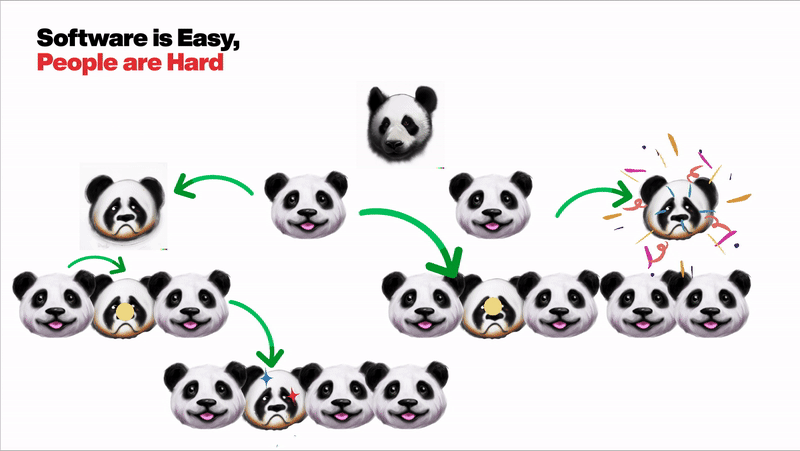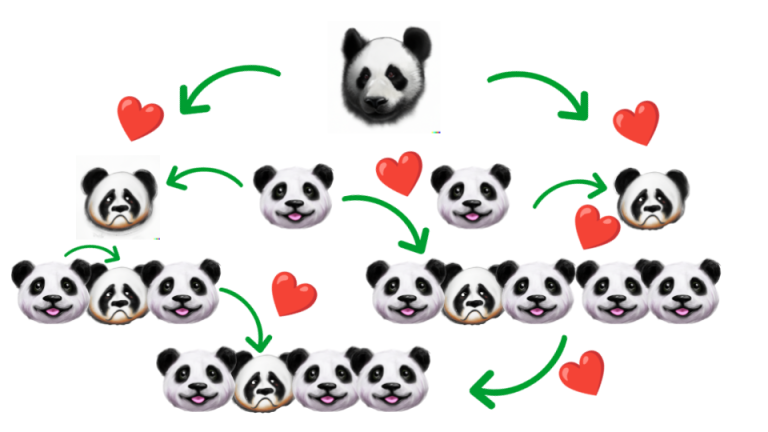What do Steve Jobs, Mark Zuckerberg, and Elon Musk have in common?
Experts have suggested that these three men show borderline signs of being psychopaths.
But they’re not the “murdery” kind of Phycopath. The definition of psychopathic behavior doesn’t in fact, cover much about killing people. At its core it focuses more on a lack of an ability to understand anything from someone else’s point of view, or a complete lack of empathy.
Clinical Lack of Empathy == Success?
Looking across the landscape of highly successful tech leaders an ability to detach yourself emotionally from the daily struggles of your people seems to be a significant key to success.
Despite this I hope we all understand that empathy is a key part of successful leadership and teamwork. Data has shown again and again that empathy in senior leadership is a superpower.
A recent study showed that 61% of people felt they could be creative in their work when their leadership showed empathy. For those that marked their leaders as lacking empathy the number was only 13%

Additionally, the study showerd that empathy was strongly linked to boosts in productivity, engagement and reduced intent to leave an organisation. However, if you google “successful tech leaders with empathy”, it returns zero real life example, only the theory.
In reality is seems that empathy doesn’t correlate with success as a senior tech leader. However, I want to show you that you CAN scale empathy and give you a simple tool that will help you build a network of empathy in your organisations.
The Empaths Path
I am not a psychopath, or in fact anywhere near. My problem lies at the other end of the empathy spectrum. I have too much empathy, the empathy I have for others causes me constant pain.
I even recently cried at the finale of season 5 of Selling Sunset, when Jason and Chrishell tragically broke up because they couldn’t find common ground on whether to have a child or not. Heartbreaking.
Towards the end of 2019, I had a small reporting line. Just two engineers. I lead well, and with empathy. Dealing with the emotional labor for two people was easy.

6 Months later I took on a group leadership position. All of a sudden I had 25 people with emotional challenges to deal with, some directly and some through supporting their managers who now reported to me. The emotional challenges started to ping up across my reporting line, dead pets, serious family health issues, and even bereavements, all alongside the general daily stress of working in a hyper-growth company.

I just couldn’t take it anymore. The culmination of all this emotional labor bubbling up through the organisational structure was causing me so much stress and anxiety, I wasn’t sleeping, I couldn’t focus. I was burning out.
Hashtag Struggling
I sought support from other senior leads in my organization, and I got the same response over and over again:
“Phil, I’m just don’t think I’m as empathetic as you, I don’t have this problem.“
I couldn’t see a way forward, it just felt that maybe empathy and senior leadership weren’t meant to co-exist. Maybe this just wasn’t the right place for me to be. Maybe you just can’t scale empathy. In parallel to this I was still really struggling, my anxiety was rising daily, and I just couldn’t sleep.
So I sought professional help. I reached you to a psychologist to help me with my issues. I got therapy.
Therapy
In my first session, we talked about my issues, and my therapists said something that sent me on an interesting journey. She said:
“It’s interesting you’re struggling with 25 reports, that’s the maximum clients I’m allowed to take on at any one time, to limit the emotional load on me”
Over the next couple of sessions, we talked a little about my problems. But mostly we spoke about the tools and techniques she used to manage her clients. We discussed how in reality, our jobs were very similar.
I started to learn more about therapy techniques, and I came across a technique that really scratched some deep itch in my brain. A technique is called “Solution Focused Brief Therapy“.
I related to it because it paralleled how we work in product development and engineering. You discover what the problem is using a specific process, then defined the solutions to those problems, and then work through them.
Solution Focused Brief Therapy
The interesting thing about SFBT is it starts by using a ‘miracle question’ to define a perfect future state. The question goes:
This may seem like a strange question to ask, but please bear with me. Imagine going about your life as normal and heading off to sleep at the usual time.Unknown to you, during the night, something happens – a miracle. When you wake up the following day, something exciting has happened.
The very problem that brought you to see me today is no longer there.What would be the very first difference you would notice in your life?
Over time I started using versions of this question with my reports. Helping us identify a perfect future state to aim for, this helped us define the steps to get there. Kind of like a sailboat retro for our brains.
Over time I realized this process was so powerful and simple that I wondered if it could be cascaded down through my reporting line. So I defined a simplified version of it and shared it with my group so see if they could help each other.
The Cascading Support System
It’s a simple 6 step process. The steps are:
Step 1: “Sup?”
The first part of the process is just checking in and seeing how the other person is. Make them feel comfortable. The chances are that if they have something that is making them feel stressed or sad, they might be anxious to share. Just ask them ‘what’s up?’ or ‘how’s it going?’ and give them the time and space to share what’s going on.
Step 2: Miracle Question
The next step is to ask the miracle question or at least a form of it, the full miracle question is a bit long and might be a bit strange to ask in this kind of context. But you can ask something similar, shorter, something like ‘If this problem went away overnight, what would it look like in the morning?’
Then truly listen to what they say.
Step 3: Context & Connection
Next try and put their problem in context, and try and make sure they feel you understand their problem. If you have a similar experience share that with them, or play their problem back to them in a context that you both understand.
The goal here is not specifically to minimize their problem, but to first show them that you have understood it, and build trust that you can help them find a solution together.
Step 4: Solutions
Now the next step should be simple for tech leads, you need to help them find solutions. This is something that we do every day, solving problems.
Work with the individual to find a solution to their problem. Outline the steps they need to take, and the steps you can support them with and flesh out a plan together.
Step 5: Check-In
Then simply set up a time to check in, and give both of you a milestone in your calendar to follow up. This gives you both a timeline to focus on your action points in the solution plan.
Step 6: Cascade/ Pass it On.
Then the sixth step is the most important part, share the process with others and ask them to try it with their colleagues, pass it on and cascade it to as many people as possible.
That’s it, 6 simple steps: ‘Sup, Miracle Question, Connect, Solution, Check On, and Cascade.

Rolling it out.
I initially introduced this concept to my group with great trepidation; I was basically asking them to run mini-therapy sessions for each other. Was I pushing them too far outside their comfort zone?
I randomly paired up people from my group and asked them to run through the process with each other, I really wasn’t sure how this would go. But they really engaged with it; some of the conversations were obviously awkward and surface level, but some of the pairs really focused on helping each other.
The result was a network of people helping each other, rather than all the emotional labor flowing up through the reporting line, it was dissipating through a network of interconnected support. The stress in the network was taken up by all the interconnecting lines, rather than bubbling up all the way to me.
With the group supporting each other, rather than all the load on me I could sleep well again at night.

You can do it!
So you can scale empathy.
You don’t need to disconnect from your reporting line, like a psychopath, to be able to be a highly successful tech lead.
I wanted to wrap up this talk with a compare and contrast saying something like:
“Using tool and processes similar to this we can make sure the next generation of tech leadership mega stars are x, y, z, rather than Zuckerberg, Jobs and Musk”
But as I mentioned before, Google suggests there are no tech leadership megastars who lead with empathy. So instead I will end with a challenge to you all. Let’s change this search result.
In 10 years’ time wouldn’t it be awesome if your name or the names of people in your organisation came up as the top google hit for “megastar tech leads who lead with empathy”?



